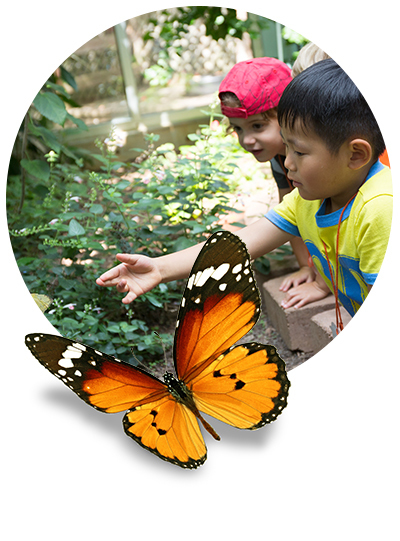Blog
Learn something new!
Proceed to the next screen to select your date and entry time
General Admission | ||
|---|---|---|
| Adults | $8 | |
| Children | $8 | |
| Children under 2 | FREE | |
| Members | FREE | |
| Next | ||
Residents of NC and SC who receive WIC or EBT benefits can visit the Museum through the Welcome Program for only $3 per person, per visit.
Closed for construction. We'll see you again soon, Charlotte!
No, they’re not from The Hunger Games. They’re yellow and black, with stiff wings and a very nasty sting- but they’re not bees! We’re talking about your friendly neighborhood yellow jackets. These fascinating members of the Hymenoptera family are social like honeybees, but they don’t make honey. So, what good are they?
If you have a garden in your community, yellow jackets are great at eating caterpillars and other pests on your plants. A colony of yellow jackets only forages about a mile from home to gather their food, so if you are seeing them frequently, odds are you’re close to their colony, or nest.

Nests have populations of 2,000 to 4,000 worker yellow jackets (all female), some drone (male) yellow jackets and up to 50 queens at once! This high population only occurs in the summer and early autumn. By late fall, the nest dwindles in population as the workers die off; only the next generation of queens will survive the winter. In the spring, they emerge from their winter dormancy and start constructing new colonies; the first queen in the nest is called the foundress. This first queen must do all the work in the start of the season; building the beginning comb structure, raising the first few workers and foraging for their survival.
Just like their cousins, honeybees, male (drone) yellow jackets cannot sting. But females are fiercely protective of the nest and have been observed biting a perceived threat to get a better grip on it before stinging multiple times. Because of the shape of their stinger and this behavior, yellow jackets can inflict a semi-circle of stings in just a few moments. But don’t think that yellow jackets are out to just sting humans. This insect developed such a defensive behavior due to the actions of predators like raccoons and skunks. These small carnivores dig out yellow jacket nests in hollow logs or underground to eat the tasty larval and pupal wasps inside. Their thick fur protects them from most of the stings – unlike our thin skin.
Honeybees feed their larvae “bee bread,” a mixture of pollen and enzymes while yellow jacket workers capture and liquefy other insects to feed the youngest members of the nest. They hunt spiders, flies, caterpillars and other small, soft-bodied invertebrates and then feed on them, regurgitating the protein to the larvae back in their cells at the nest. If they find an easy protein source, like roadkill or your uncooked hamburger patty waiting for the grill, they’ll take advantage of it. When the workers arrive back at the nest, the larvae they then feed provide the adult yellow jackets with a sugary secretion that boosts their energy for the next foraging flight they make.
In early fall, the worker yellow jackets switch to searching for sources of sugar, like flower nectar or your glass of sweet tea to bring back for the queens in the nest, who must fatten up to survive their winter dormancy. Because they have less to do at the nest, workers may also be found more often just flying around, seemingly aimlessly and often “getting into trouble” around human dwellings.
While no one likes being stung, these insects have a fascinating social structure and deserve our respect, just like everything else in nature. Though, hopefully, we can respect them from the other side of a window screen.

Looking for kid-friendly things to do in Charlotte? Fun and learning go wild at Discovery Place Nature! Children will love to explore the easy-to-navigate Museum and discover live animals, daily shows, hands-on demonstrations and creative play areas.
| Time | Event | Location |
|---|---|---|